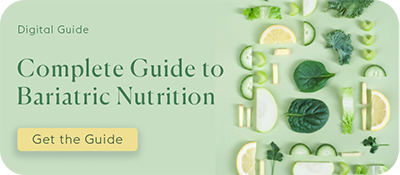Before or after your weight loss surgery, you may be looking for details of what a gastric sleeve diet would look like for a bariatric patient. Getting to surgery can take several months, so if you’re here before your bariatric procedure and curious about what life will look like long-term after a gastric sleeve, we hope you will receive a lot of helpful information from this blog. Also, the gastric sleeve and bypass diets are pretty similar in concept, so feel free to use this as a guide for either surgery.
Gastric Sleeve Diet: Immediately After
In the immediate week after a gastric sleeve, we recommend patients stay on liquids including water, Crystal Light, unsweetened tea with some Splenda, Powerade Zero, and other low-sugar drinks. Usually, in the first week, we will start integrating protein shakes into your diet. These are high-protein, high-nutrition, low-calorie shakes that will allow you to start putting some protein in your diet to help with the healing process.
Gastric Sleeve Diet: Week 1
By the first week after surgery, the patient will begin transitioning to a liquid diet that has more substance, such as thicker soups that are a puree consistency. We recommend thin oatmeal, grits, and some apple sauce. During this time, we are constantly striving for the patient to get as much protein as possible, especially in the early phase when healing is critical.
Yet, the cornerstone of the gastric sleeve diet in the first few weeks remains hydration. We tell our patients early on that we want them to get enough fluids to stay hydrated. You will feel so much better after surgery if you are properly hydrated.
Gastric Sleeve Diet: Week 4
We see patients back in the office about a month after surgery. At that point, patients usually advance their diet to be a little more robust. They are trying some soft, flaky fish and some tender cuts of meat. We recommend eating foods cooked in a slow cooker or a Dutch oven rather than food that has been fried or grilled.
Gastric Sleeve Diet: Month 3
When we see the patients again by the three-month mark, most patients can eat the same things that others in their families eat. We just ask the patients to eat healthier, smaller portions.
One of the great joys is seeing patients start to eat healthier and then see their family and friends eating more nutritious meals. This new way of eating is a long-term commitment, and patients are eating “real food” that will hopefully teach others in their lives how to eat healthily.
Gastric Sleeve Diet: Long-term
Long-term, the diet for gastric sleeve patients is real food that focuses on protein-heavy and vegetables. We recommend our patients avoid bread, rice, pasta, and potatoes and instead increase nutrients to get full off of whole foods, not carbs and liquid calories. We want to stick with zero-calorie liquids like the ones listed earlier.
Dietary Goals after Gastric Sleeve Surgery
The dietary goal for gastric sleeve patients includes about 800 to 1,200 calories in a day. Of course, there is flexibility if the patient is working out excessively in the gym. The protein goal we would recommend is 60 to 80 grams of protein a day. Usually, one of those protein sources will come from a protein shake between 20 and 30 grams of protein a day.
Vitamins and Supplements
We highly suggest taking vitamin D and calcium supplements and of course incorporating a bariatric multivitamin. Lastly, we recommend finding a vitamin B complex containing B1, B6, and B12. There are liquid forms of this that absorb very well.
Portion Control
Regarding what your plate should look like, it should be mostly protein on your plate, some veggies, and low carbs. Most health sites will tell you to follow the 50/25/25 rule, meaning divide your portions by having 50% of your meal be vegetables, 25% be protein and 25% be starchy vegetables or carbohydrates. However, after bariatric surgery we recommend following a 60/40 rule, meaning cover your plate with about 60% protein and 40% green vegetables.

